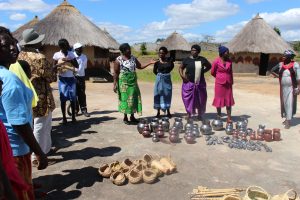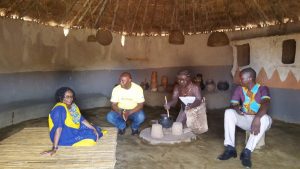By Byron Mutingwende
The Shona Village is helping people locally and from across the globe to understand and appreciate the national culture. It is situated at Great Zimbabwe World Heritage site that was declared a National Monument in 1937 and a World Heritage Site in 1986.
The village is an ethnographic depiction of continuing traditional lifestyles since the Great Zimbabwe period to present day. It offers a general representation of the dynamic Shona Culture and traditional practices in such aspects as architecture, social, economic and political practices, education and entertainment, performing arts, fine arts, crafts and traditional healing. The village plans to provide overnight accommodation to tourists who wish to experience the African night in traditional houses constructed using traditional methods and styles.

“Generations of Heritage managers realised that there is need to establish a living museum at the site to aid in the presentation and preservation of the shona culture as well as add value to Great Zimbabwe World Heritage Site. This implies that Great Zimbabwe is not only a gift to Zimbabweans, neither is it a gift to the region and Africa only but it is a gift to the entire world,” said Lovemore Mandima, the Director of the Southern Region of the National Museums and Monuments of Zimbabwe (NMMZ).
The Great Zimbabwe is divided into three major concentric zones which are the Hill Complex, the Valley Enclosure and the Great Enclosure. It is also a cultural and archaeological site. In 1980, it gave its name to the country and arguably became the only known cultural site that has given its name to a great nation like Zimbabwe.
“Apart from the silent, dry stone walls found at Greta Zimbabwe, NMMZ in its widom and also deriving this wisdom from international standards in heritage management thought of coming up with a model of a traditional Shona Village as an addition to the dry stones. The idea behind is that of educating its visitorship in its entirety on the differnet aspects of the Shona culture hence the artefacts one finds at the Shona village give a vivid picture of the Shona way of life.
“These include the traditional ways of harnessing food, iron smelting, pottery and basket making, wood and stone carving and the concept of polygamy, just to mention a few,” Mandima said.
Priscah Mupfumira, upon assuming office as the Minister of Tourism and Hospitality Industry in the new dispansation and as part of the 100-day initiative to turnaround the economy, travelled to Great Zimbabwe and spent time at the Shona Village in her thrust to promote local tourism.

“As minister, I found it worthwhile to visit the Shona Village and experienced first-hand this great depiction of our culture and heritage. In pursuit of promoting domestic tourism, such cultural and heritage sites should be marketed and promoted extensively especially among our children and students for them to have a better understanding of our history and socio-cultural values,” Mupfumira said.
The Shona Village is significant in many ways. It is an educational facility. Learners (primary and secondary, students from tertiary and other research institutions especially on culture) use the Shona Village for educational purposes. Traditional games such as tsoro and pada are also part of what’s depicted in the Shona Village.
“The tenants are drawn from five local chieftainships (Mugabe, Murinye, Nemamwa, Charumbira and Shumba). The village has since its inception proved to be a good source of livelihood. This augurs well with the concept of community involvement which is one of the keyexpectations in contemporary heritage management,” Mandima said.
Lilian Hodges established the first Cultural village at Great Zimbabwe in 1964.The village was known as the Karanga Village and was located near the site museum. The main attraction was the traditional healer.
The Karanga Village was closed in the late 1970s at the height of the liberation struggle. The village was opened at a new location; its present location between the eastern enclosures and the valley enclosures and it was named Shona Village (19th century Shona Village).
The village was again closed in the 1990s for conservation purposes, artefacts were deteriorating due to moisture and the location itself had its own shortcomings in regard of the site presentation. In 2000, a group of consultancy was hired to look into the feasibility of the village with the main aim being to find a new location among others. It was finally agreed that the village be located to the north east of the monument near the road to Mtirikwi Dam.
The name was changed to the Traditional Village and it showcased cultures of different ethnic groups. The location was not popular to the incumbent tenants, the majority gave up and unfortunately the village was gutted by a veldt fire in 2004. A visitor survey was carried out and it became apparent that the visitors wanted the village site in the monument and the curators concurred with this idea.
In 2007 the NMMZ received a grant from Culture Fund Zimbabwe Trust to construct the relocated Traditional Village. The project could not be completed due to hyper inflation. In 2013 Culture Fund in partnership with Sweden availed a grant to finish the project. Again in 2015 Culture Fund in partnership with the European Union availed a grant for a Fully Operational Village at Great Zimbabwe. The name of the village was changed to Shona Village after a stakeholder consultative forum.
It is against this background of adaptation and adaptation of this cultural village which shows that the Shona Village is a focal point of preservation, presentation and promotion of the vanishing Shona Culture. The village is also vital for the social economic transformation of the local communities
